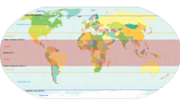In astronomy, axial tilt, also known as obliquity, is the angle between an object's rotational axis and its orbital axis, which is the line perpendicular...
33 KB (3,103 words) - 21:08, 4 October 2024
Earth (section Axial tilt and seasons)
equinox dates swapped. The angle of Earth's axial tilt is relatively stable over long periods of time. Its axial tilt does undergo nutation; a slight, irregular...
218 KB (19,312 words) - 06:41, 3 October 2024
Milankovitch cycles (section Axial tilt (obliquity))
Milanković. In the 1920s, he hypothesized that variations in eccentricity, axial tilt, and precession combined to result in cyclical variations in the intra-annual...
49 KB (5,221 words) - 02:03, 26 September 2024
Season (section Axial tilt)
a given region. On Earth, seasons are the result of the axial parallelism of Earth's tilted orbit around the Sun. In temperate and polar regions, the...
59 KB (6,454 words) - 19:01, 26 September 2024
Retrograde and prograde motion (section Axial tilt)
retrograde orbit. A celestial object's axial tilt indicates whether the object's rotation is prograde or retrograde. Axial tilt is the angle between an object's...
40 KB (4,642 words) - 01:34, 27 August 2024
directly overhead. This is because of Earth's axial tilt; the width of the tropics (in latitude) is twice the tilt. The tropics are also referred to as the...
17 KB (1,843 words) - 00:14, 26 September 2024
Ceres (dwarf planet) (section Rotation and axial tilt)
equatorial crater of Kait is selected as its prime meridian. Ceres has an axial tilt of 4°, small enough for its polar regions to contain permanently shadowed...
130 KB (12,686 words) - 18:27, 15 September 2024
Earth's orbital position is marked at the summer solstice, when the Earth's axial tilt is pointing directly toward the Sun. One full orbit later, when the Sun...
60 KB (8,341 words) - 20:53, 3 September 2024
Uranus (redirect from Tilt of Uranus)
(−224 °C; −371 °F)) of all the Solar System's planets. It has a marked axial tilt of 82.23° with a retrograde rotation period of 17 hours and 14 minutes...
158 KB (15,618 words) - 13:17, 3 October 2024
Planet (section Axial tilt)
the planet. Jupiter's axial tilt is very small, so its seasonal variation is minimal; Uranus, on the other hand, has an axial tilt so extreme it is virtually...
197 KB (20,760 words) - 10:27, 27 September 2024









